“We typically see a lot of hiccups when starting with a new team,” the client said. “But there were none with Softjourn.”
Case Study: How Softjourn Catapulted Sales, Doubling Client's Growth in Record Time

ABOUT THE CLIENT:
The Challenge
The client approached Softjourn for a dedicated development team to support its cloud-based expense management automation product. After a merger and an acquisition, their internal team was moved to other in-house tasks, leaving the company’s core product with minimal support.
The Solution
To ensure the ongoing maintenance and development of the client’s core product, Softjourn collaborated closely with in-house team members to come up with an extensive transition plan. By partnering with Softjourn, they received a full team focused on their specific needs: three .NET senior full-stack developers, a QA engineer, and a project manager.
The Benefits
- Additional staff and resources as needed throughout the project and collaboration lifetime
- Ongoing maintenance and updates to the client’s complex system of integrations, including QuickBooks Online and Finicity
- Developed and enhanced core features, such as an administrator dashboard
The Challenge
For almost two years, scrutiny of business expenditures has grown as many businesses still use manual processes to manage travel and expense reporting. Emburse’s 2021 Travel & Expense Management Trends Report states that 45% of small businesses rely heavily on manual processes—including pen and paper—, Excel spreadsheets, homegrown systems, or a combination of these.1
Automating expense management processes reduces 90 to 95% of a company’s paperwork,2 reduces or eliminates processing and communication issues, and supports financial tracking that leads to smarter savings and investments. Cloud-based expense management solutions also need not be so expensive that smaller enterprises cannot afford them.

Our client has a system offering a faster and easier expense management reporting process for employees, administrators and accountants alike. 91% of their users report that this software makes it easier to reimburse employees, 71% saved between two and 6 or more hours per week by using the software, and two out of three customers chose the solution because of its intuitiveness.
For companies offering cloud-based expense management software, decreasing or even eliminating downtime is important, not just for customer acquisition and retention, but for the longevity of the product and the company itself. According to the Consortium for IT Software Quality, the biggest contributing factor to revenue loss is software failure—37.46%3. As of 2018, this amounted to $2.84 trillion in the US alone.
The client approached Softjourn for a dedicated development team to support its cloud-based expense management automation product. After a merger and an acquisition, their internal team was moved to other in-house tasks, leaving the company’s core product with minimal support.
Since software continually grows and evolves, the client was looking for a partner to support, maintain and further develop their product.
With almost a decade of experience in developing expense management software for corporate users, the client was in good hands with Softjourn’s development team.
The Solution
To ensure the ongoing maintenance and development of the client’s core product, Softjourn collaborated closely with in-house team members to come up with an extensive transition plan. The document outlined planned milestones covering all aspects of maintaining the service.
By partnering with Softjourn, they received a full team focused on their specific needs: three .NET senior full-stack developers, a QA engineer, and a project manager.
The transition plan also included an outline of knowledge transfer meetings, explaining what would be most valuable for both Softjourn and our client so that the dedicated Softjourn team members would be able to make the right decisions without the client’s involvement. Softjourn’s goal is always not just to understand individual tasks but to have a good sense of the client’s overarching goal.
“We were very proactive in this phase,” said Yevheniya S., Softjourn project manager. “For example, we outlined that we would need access to certain documentation and personnel while explaining how we would use our time—whether hourly or week by week—in order to get up to speed on their system quickly.”
QuickBooks Integration
To ensure that the two companies were the right fit, our client’s team tasked Softjourn with the preliminary task of upgrading its QuickBooks Online integration. Softjourn stepped up to the task, ensuring there were no delays or issues in either the hand-off or the start of the project. In addition to assisting with integration, the team made a list of QuickBooks Online features that could be added to the client’s product in the future.
“We typically see a lot of hiccups when starting with a new team,” the client said. “But there were none with Softjourn.”
Eventually, 900+ new clients migrated to the new QuickBooks Online integration. Softjourn also developed a tool so that the client’s team members could migrate additional clients from time to time. This tool provided a framework for improvements to another client’s project, providing a good head start.
“The team has been excellent,” the client said. “They met all of their deadlines or finished early.”
Test-Driven Development (TDD)
The client favored test-driven development (TDD), and Softjourn conformed to that standard. According to research conducted by Microsoft and IBM, while TDD can result in longer initial development times, it can also save time that would have otherwise been spent on correcting errors.4 IBM testing teams reported a 40% reduction in defects as a result of TDD, while Microsoft teams reported a 60-90% drop. Other studies report that TDD results in cleaner, easier-to-read code that allows for greater maintainability.5
Softjourn also aided in resolving end-user issues, in cooperation with the client’s customer support staff.
Additional Responsibility
Throughout the two-year ongoing collaboration, our client placed an increasing amount of responsibility on Softjourn. Eventually, Softjourn team members became responsible for deploying production releases.
Softjourn has also taken on development work and added several enhancements to the client’s product, including premium-level features to increase revenue and improvements to their administrator dashboard that allowed for batch processing expenses by different filters.
The Benefits
- A dedicated, self-managing team consisting of .NET senior full-stack developers, a QA engineer, and a project manager who proactively looked to constantly enrich the client’s core product based on the client’s product roadmap
- Additional staff and resources as needed throughout the project and collaboration lifetime
- Ongoing maintenance and updates to the client’s complex system of integrations, including QuickBooks Online and Finicity
- Developed and enhanced core features, such as an administrator dashboard

Conclusion
Our team was able to reduce downtime for the client’s SaaS expense management product and contribute to the company’s success. The client could see the immediate benefits of all system updates when their sales numbers doubled at end of the year.
The client has been extremely pleased with our work so far, and shared the impact with our team. Softjourn will continue to support this project with ongoing maintenance and feature development.
“After working with the team for a while, our expectations are high and remain high because of historical performance,” the client said. “When I see there’s nothing outstanding, it’s because [Softjourn] continues to adhere to a high standard.”
Partnership & Recognition







